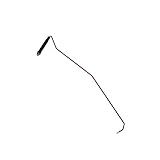Best PHP Regex Tools to Buy in December 2025
Regular expressions are powerful tools for pattern matching and text manipulation. In PHP, they are implemented through the PCRE (Perl Compatible Regular Expressions) library.
To start using regular expressions in PHP, you need to use the built-in functions that work with regular expressions, such as [preg_match](https://phparea.com/blog/how-to-use-preg_match-in-php), preg_match_all, preg_replace, and others.
To perform a basic pattern match using regular expressions, you would typically use the preg_match function. It takes two main arguments: the pattern you want to match and the string you want to search within. The function returns true if the pattern is found or false otherwise.
For example, suppose you want to check if a string contains a valid email address. You can use the following code:
$email = "example@example.com"; $pattern = "/^\w+([\.-]?\w+)*@\w+([\.-]?\w+)*(\.\w{2,3})+$/";
if (preg_match($pattern, $email)) { echo "Valid email address!"; } else { echo "Invalid email address!"; }
In the above code, the email address pattern is defined using a regular expression. The pattern starts with ^ to indicate the beginning of the string, followed by \w+ to match one or more word characters (letters, numbers, and underscores). The pattern then checks for the presence of a dot and an alphanumeric domain name, and ends with \.\w{2,3} to match a top-level domain like .com or .net.
You can also use regular expressions to extract specific portions of a string. The preg_match_all function can be used for this purpose. It works similarly to preg_match, but it returns an array of all matches found in the string.
To replace parts of a string using regular expressions, you can use the preg_replace function. It allows you to search for a pattern in a string and replace it with a specified replacement string.
Regular expressions in PHP support a wide range of modifiers, such as i for case-insensitive matching, g for global matching, and m for multiline matching. These modifiers can be helpful in various scenarios when you need to customize the behavior of your regular expressions.
In conclusion, regular expressions are a powerful tool in PHP for pattern matching and text manipulation. They allow you to search for specific patterns, extract information, and replace parts of a string. Understanding regular expressions can greatly enhance your ability to work with textual data in PHP.
Can you match optional characters using regular expressions in PHP?
Yes, in PHP regular expressions, you can use the question mark "?" to match optional characters. The question mark makes the preceding character or group optional, meaning it can appear zero or one times.
For example, to match both "color" and "colour" in a text, you can use the regular expression "/colou?r/".
Here's an example code snippet in PHP:
$text = "The color of the wall is blue.";
// Match both "color" and "colour" if (preg_match("/colou?r/", $text, $matches)) { echo "Match found: " . $matches[0]; } else { echo "No match found."; }
The output of this code will be: "Match found: color".
How can you validate dates and times using regular expressions in PHP?
To validate dates and times using regular expressions in PHP, you can use the preg_match() function along with the appropriate regular expression pattern. Here are a few examples:
- Validate dates in yyyy-mm-dd format:
$date = "2021-12-31"; if (preg_match("/^\d{4}-\d{2}-\d{2}$/", $date)) { echo "Valid date."; } else { echo "Invalid date."; }
- Validate dates in mm/dd/yyyy format:
$date = "12/31/2021"; if (preg_match("/^\d{2}\/\d{2}\/\d{4}$/", $date)) { echo "Valid date."; } else { echo "Invalid date."; }
- Validate times in hh:mm format (24-hour format):
$time = "13:30"; if (preg_match("/^(?:[01]\d|2[0-3]):[0-5]\d$/", $time)) { echo "Valid time."; } else { echo "Invalid time."; }
- Validate times in hh:mm format (12-hour format with optional am/pm):
$time = "09:45 pm"; if (preg_match("/^(0?[1-9]|1[0-2]):[0-5]\d(\s?[ap]m)?$/i", $time)) { echo "Valid time."; } else { echo "Invalid time."; }
Note that these regular expressions provide basic validation and do not take into account specific date ranges or leap years. For more advanced date and time validation, you may need to consider using PHP's built-in date and time functions or a dedicated library.
How do you match a specific character using regular expressions in PHP?
To match a specific character using regular expressions in PHP, you can use the following code:
$regex = "/specificChar/"; // Replace "specificChar" with the character you want to match
$string = "Example String";
if (preg_match($regex, $string)) { echo "Match found!"; } else { echo "No match found!"; }
In this example, you need to replace "specificChar" with the character you want to match. The forward slashes ("/") are used to delimit the regular expression pattern.
The preg_match() function is used to perform a regular expression match on the given string. It returns true if a match is found, and false if not.
Note that if you want to match a special character with meaning in regular expressions (for example, "*", ".", "?"), you need to escape it with a backslash ("") like "\*", "\.", "\?".
How do you create a regular expression in PHP?
To create a regular expression in PHP, you can use the built-in preg_ functions. Here's a step-by-step guide:
- Start by declaring the regular expression pattern as a string. For example, if you want to match a phone number in the format xxx-xxx-xxxx, the pattern would be "/\d{3}-\d{3}-\d{4}/"
- Use the preg_match() function to check if a string matches the pattern. It returns true if there is a match, false otherwise. For example:
$pattern = "/\d{3}-\d{3}-\d{4}/"; $string = "123-456-7890"; if (preg_match($pattern, $string)) { echo "Phone number is valid"; } else { echo "Invalid phone number"; }
- Use the preg_replace() function to search and replace parts of a string that match the pattern. For example:
$pattern = "/John/"; $string = "My name is John Doe"; $replacement = "Jane"; $newString = preg_replace($pattern, $replacement, $string); echo $newString; // Output: "My name is Jane Doe"
These are just a few examples of using regular expressions in PHP. There are many other preg_ functions available to perform various operations with regular expressions, such as finding all matches with preg_match_all() or splitting a string based on a pattern with preg_split().
How can you match a range of characters using regular expressions in PHP?
To match a range of characters using regular expressions in PHP, you can use character classes or character ranges within square brackets "[" and "]" in your regular expression.
Here are a few examples:
- Match any single lowercase letter from "a" to "f":
$pattern = '/[a-f]/';
- Match any single digit from "0" to "9":
$pattern = '/[0-9]/';
- Match any single uppercase or lowercase letter:
$pattern = '/[a-zA-Z]/';
- Match any single lowercase vowel:
$pattern = '/[aeiou]/';
- Match any single digit or uppercase letter:
$pattern = '/[0-9A-Z]/';
Remember to use the appropriate regular expression functions in PHP, such as preg_match(), to test if a string matches the desired pattern.




